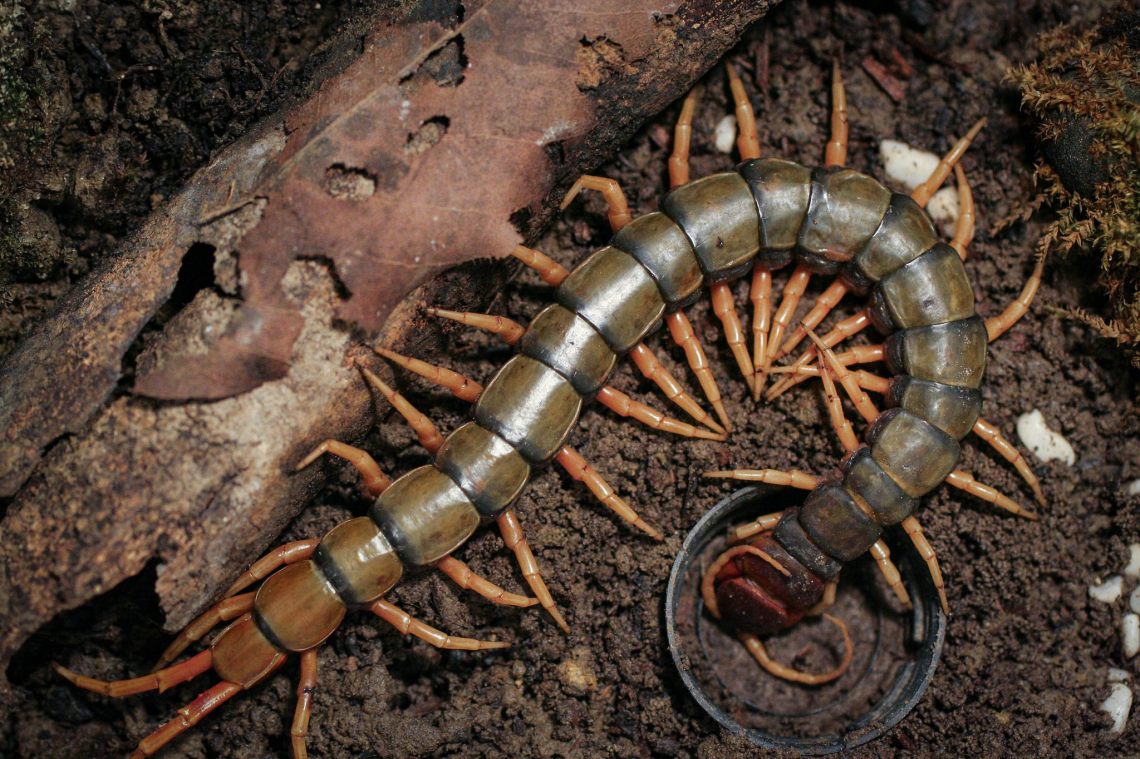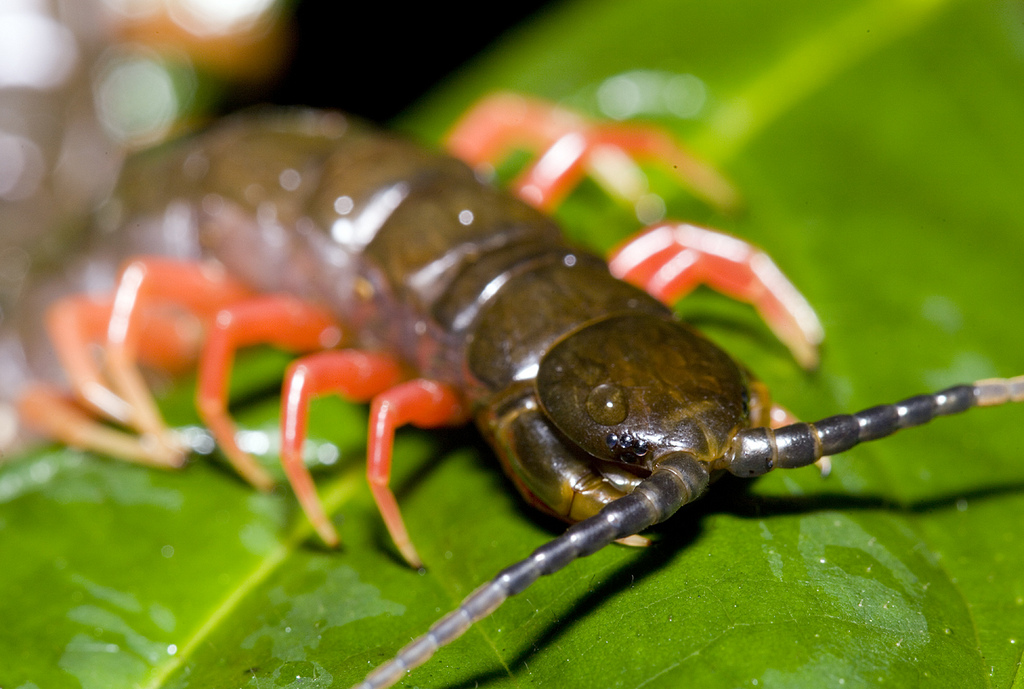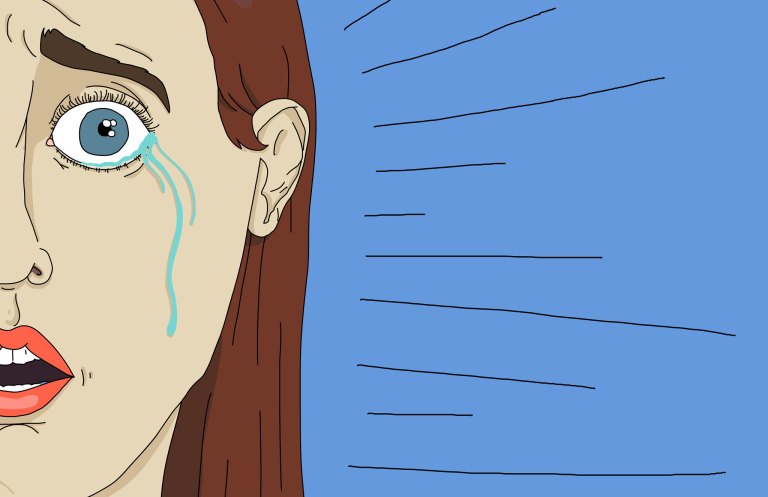The Centipede Feeds: Predator Porn On YouTube

[youtube https://www.youtube.com/watch?v=1mczp89kRSc%5D
Neither William Ian Miller’s theories, in The Anatomy of Disgust, or Rachel Herz’s, in That’s Disgusting: Unraveling the Mysteries of Repulsion, fully account for the primordial, profoundly visceral disgust the centipede inspires, a deep-rooted psychological nausea that is at least as old as Leviticus and as recent as the collective shudder of loathing that ripples through comment threads on YouTube videos of centipedes eating mice (usually “pinkies,” as hairless newborns are known).
Videos of pet Scolopendromorphs devouring their hapless prey constitute a thriving subgenre of what might be called predator porn—the videos of wild-animal attacks (“World’s Deadliest: Grizzly Bear Attacks Prey,” “Lion Attacks Elephant: Brutal Kill Caught On Camera,” “Animal Face-Off: Hippo vs. Bull Shark”) that proliferate on YouTube. Centipede hobbyists tend, by my thoroughly unscientific reckoning, to be young men who thrill to the gross-out awesomeness of a ferocious predator in action: over jerky, hand-held footage of the centipede’s whiplash-fast attack and the ensuing slasher-movie gore of the animal gobbling up its prey, we hear whoahhh, dude gasps and Beavis-and-Butthead sniggers. Some centipede fanciers enhance these nutshell studies of nature red in tooth and claw with soundtracks of ominous electronica or thudding industrial techno or, in the case of one hobbyist with an especially perverse sense of humor, Tiny Tim singing “Livin’ in the Sunlight, Lovin’ in the Moonlight,” in his usual shriekingly twee manner.
A video of a Vietnamese centipede devouring a live mouse is typical of the genre: in a dirt-strewn terrarium, a large specimen (Scolopendra subspinipes, from the looks of it) clutches a baby mouse tight in its prehensile legs, like a dance partner from Hell. The centipede’s jointed shell is the color of dried blood; its clawlike legs, sharp as pinpoints at the tip, are a dull, butterscotch yellow. Having paralyzed the mouse with a shot of neurotoxin from its forcipules (the first pair of legs, modified by evolution into venomous pincers), the arthropod is gnawing its way, unhurriedly, through the rodent’s exposed brain. What makes the footage so ghastly is the centipede’s loving attentions to its prey, the obscene tendresse of its nibbling. Mewling pitifully, the mouse makes stiff-legged rowing motions, as if dog-paddling on dry land. Off-camera, a male voice says, “It’s still squeaking? Dude, that’s so horrible! Nature is fucked up! Oh, it’s literally, like, eating its brains out, man! Half of its head is gone…”1 Another guy giggles.

Is there a personality type that gravitates toward giant centipedes? If YouTube videos are any indicator, the demographic is dominated by the whoahhh, dude contingent: guys (18-24, judging by their male-bonding bro-speak) who are square-brained enough to believe a badass pet will bolster their testosterone levels, yet too weird for pit bulls. To be sure, some centipede hobbyists are entomology enthusiasts with a genuine scientific curiosity about the animals; they frown, in their comments, on the Grand Guignol vulgarity of owners who post videos of their pets eating pinkies, geckos, and other trapped, defenseless creatures. “I keep various Scolopendra and have to say there is no reason to feed it live [prey],” says one commenter. “Not the way I like to see the hobby represented at all. Like some sort of sick gladiatorial event.”2 But on YouTube, at least, centipede fans seem to consist mostly of geeks in search of a masculinity totem or, alternatively, goths and other socially maladjusted miserablists who feel a twisted kinship with creatures who, like them, are abominated by normals.
The owner who posted images on the photography website Photo Forum, in a discussion group called “Dark Side Gallery,” is a textbook example of the last type—brooding, alienated, and unapologetically identified with creeping things that creep upon the earth, oozing malice (not to mention venom). “You want darkside?” he writes. “Keep vicious 8” long centipedes as pets.”
My darkside consists of my closet space. I walk in the room and see snakes slithering around, watching my every move. I see tarantulas rear up and expose their fangs, ****ed off at my mere presence. I see scorpions arch their tails high above their heads, venom droplets visible, wanting nothing more than to envenomate me. I see giant centipedes show me their focipules [sic] in anger. When the lights go out, its [sic] a cacophony of sounds of creatures unseen. The clacking of their invertebrate bodies against the glass as they track down and envenomate prey. The sounds of the snakes hissing as they sink their fangs into their prey. The screeching of the centipede claws on the glass as they try all night to escape. The sounds of tarantulas scurrying around their cages. Yes, my closet is my “darkside.” May these images send chills down your spines, may they give you nightmares, may they repulse you. Of course I love these animals and they’re often misunderstood…3
Bonding with an abomination whose very appearance, much less touch, inspires skin-crawling disgust sends the unambiguous message that the pet owner doesn’t want to be a member of any species that would have him as a member. Pinkie snuff videos underscore this point emphatically, opening a chasm between those whose sympathies lie with their own kind, the Mammalian class—personified in these Darwinian dramas by the hairless, helpless baby mice, so disconcertingly reminiscent of human newborns—and those whose misanthropic politics align them with alien classes like Arachnida (home to spiders and scorpions, among others) and Chilopoda.

The disgust, spiked with horror and outrage, that erupts in the comment threads below videos of pet centipedes feeding gives vent to the fear and loathing most humans feel at the sight of a nauseating abomination slurping up the brains of a mouse, which is to say: one of ours—a mammalian relative with whom we share a common ancestor, 80 million years back, and therefore at least 85% of our genes, if not more.4 “I’ve killed my share of mice but how can you stand by and watch an unclean ancient horror stalk and eat a fellow mammal?” writes a commenter, transposing centipede loathing into the key of H.P. Lovecraft. “I’d chop that creature up into little bits for the benefit of all mammals.”5 Even the sight of a snake or a gecko being eaten alive inspires indignation: snakes are cold-blooded reptiles, yes, but they’re aesthetically appealing in a way that centipedes, to most of us, are not; likewise, geckos are lizards, but they’re cute enough, with their large, liquid eyes, to play on our Disneyesque weakness for anthropomorphizing.
Turning up the volume on the live feed from YouTube’s collective unconscious, we hear: “Centipedes are the most alien-like things on earth…”6 “Those things need to be wiped off the planet. Purge them all from existence.”7 “Stomping on it won’t be enough maybe u should nuke it from orbit, just to be sure.”8 “Why would anyone want to preserve or raise such a disgusting creature? Leave their vile existence to natural selection.”9 “The way the centipede kills is cruel. Furthermore, a centipede has little to no intelligence and is incapable of feeling or returning love. Feeding them intelligent animals which are much more capable of feeling/returning love is disgusting. Honestly, I want the intelligent/emotional animals to thrive. Insects that kill mammals…should be killed…”10 “To see other mammals be devoured by insects and not sharing any empathy for said mammal makes you a sociopath.”11 “Sociopathic characteristics inspire this type of thing. I bet the owner is a cross-dressing road sweeper who masturbates over Guns and Ammo magazine.”12 “This makes me sad. I despise these primordial horrors.”13 “I hate things with lots of legs because it makes me want to shed my skin.”14
Overrun by juvenile delinquents, aspiring sociopaths, conspiracy theorists, and moist-palmed habitués of PornHub, YouTube discussions are notoriously depressing spectacles; it’s the rare thread that doesn’t devolve into a race-baiting, gay-bashing, F-bombing, LOL-ridden brawl. Still, there are diamonds in the dung-heap—comments that, wittingly or not, expose the buried logic, cultural and evolutionary, behind the profound disgust many of us feel at the sight of a centipede.

One recurrent theme in YouTube comments on centipede videos is the latent fear that, wise ape though he may be, Homo sapiens has only temporarily triumphed over the most numerous, evolutionarily successful phylum on the planet, Arthropoda. Percolating through these threads is an unsettling sense of the inhumanity of the insect race: the unblinking blankness of its eyes, whether compound or ocelli, unmoving and unmoved by anything;15 the frenzied, fingerlike working of its mouthparts; the blue-green hemolymph it calls blood. From an anthropocentric vantage point—and what other perspective does man, the only animal capable of narcissism, ever adopt?—the insect is always disquieting, often horrifying: horrifying in its unthinking brutality—tearing its living prey to pieces with its mandibles, decapitating its mate in mid-coitus, eating its own young if disturbed by human interlopers; unnerving in its facelessness, its namelessness—a coglike anonymity embodied in its exoskeletal armor, which makes any individual member of a species identical to any other, and epitomized by its role as an interchangeable social atom in the swarm, the hive, the mound, the army of ants on the march, devouring alive any prey in its path; horrifying in the mindlessness that makes it seem more like a wind-up toy than a living thing, exemplified by the centipede’s grotesque ability to jitterbug after being cut in two.
Recalling his freakout at the sight of the amputated headquarters of a scolopendrid scurrying around his collection tray, headless but no less energetic for that, Greg Edgecombe, an arthropod paleontologist at the Natural History Museum in London, says, “That’s possibly the first case I’ve ever found myself almost frightened by a centipede. I’m often interested in the brain anatomy of arthropods and, you know, we do give the brain considerable importance as the engine of our behavior and you think, ‘If you don’t have a bloody brain, how can you control something as complex as locomotion?’ Especially with the back end; if the front end, with the brain, is walking around, I can kind of get that…”
[youtube https://www.youtube.com/watch?v=z1yVHNb-j6c&w=784&h=588%5D
Edgecombe, like the YouTube commenters, puts his finger on a root cause of the centipede’s repugnance, an aspect of disgust that seems never to have occurred to Herz or Miller: the sheer alienness of the thing. An irrational, species-ist recoil from the utterly Other may go far in explaining why most of us find the centipede so abhorrent. By “utterly Other,” I mean: that which is so incommensurate with the human frame of reference that it cannot, by any stretch of the imagination, be anthropomorphized. To those who find it disgusting, the centipede is “the most alien-like thing on earth,” and not just alien but implacably hostile to Mammalia.
Hence the abject horror at pinkie snuff videos, and the indignation at “sociopaths” who gleefully watch “primordial horrors” “incapable of feeling or returning love” sucking the brains of “intelligent/emotional” mammals who are enough like us to merit our empathy (defined, in the cynic’s dictionary, as the warm feeling Narcissus got when he gazed into the eyes of his reflection). Hence, also, the appalled fascination with the centipede’s ability to survive bisection, however briefly, something no mammal could do.16 Hence, too, the disgust triggered by the centipede’s numberless, wiggling legs. The centipede’s legs have been metonymic, at least since Leviticus, for all that is disgusting about the creature. The Old Testament lawgiver singles out for special opprobrium whatsoever hath more feet [than four] among all creeping things that creep upon the earth, yet exempts from his dietary prohibition “the locust after his kind, and the bald locust after his kind, and the beetle after his kind, and the grasshopper after his kind.”17 Clearly, it’s the legs that make the abomination, the more of them the more abominable because further from human, more revoltingly alien.
And not just the legs, but the gait: the centipede’s frenetic scuttlings and snakelike undulations push the buttons of our disgust. (Leviticus’s exceptions to his proscriptions, note, are all insects that hop.) Miller agrees that “wriggly, slithering, creepy things make us cringe and recoil,” but doesn’t say why.18 Neither does R.F. Lawrence when he notes, in The Centipedes and Millipedes of Southern Africa, that centipedes “inspire a certain healthy prejudice in most people, who are revolted by their all too many legs and wriggling movements.”19 Herz, for whom “the tickle across our toes” of “wriggling centipedes” is a textbook example of the disgusting, hazards an explanation: “squirming, jiggling, and twitchy movements are more aversive than stillness or straight and smooth movements,” she speculates, because they’re “likely to correspond to sick and contaminating things.”20

This seems like a bit of a stretch. Isn’t it more likely that creeping things darting toward us on too many legs to count disgust us because eight legs, as any arachnophobe knows, is bad enough, but innumerably many legs is simply not of this world, so hideously alien the hundred-footed horror should be stomped into paste, then nuked from orbit, just to be sure? Charismatic megafauna like the Giant Panda, which ranks high on the adorability scale and practically begs us to anthropomorphize it, win our affections; fearsome predators like the African lion, which has served us well in myth and symbolism, earn our awe and admiration. But we have little room in our hearts for the monstrous; if man is made in God’s image, as scripture teaches, then ugliness is far from godliness, and therefore richly deserving of extermination. The phrase “ugly as sin” is instructive: in societies whose cultural unconscious is structured by magic, myth, or religion, outward appearance is a legible record of inner life; disease, deformity, or ugliness give palpable form to intangible evil. Hideous to behold, nasty in its habits, the centipede disgusts because it is ugly and because it is evil, its ugliness proof of its evil—or so says the logic of magical thought.
The evil embodied by the centipede harks back to the night terrors of the earliest hominids—to a fear of things not merely inhuman but anti-human, relentless competitors for dominion over the Earth. The centipede is a disquieting reminder that whereas Homo sapienshas been here for 200,000 years at best, Chilopodarose about 416 million years ago. The fossil record of the Devonian is the opening page in their family photo album. Theirs is an ancient line, stretching back to the Devonian. They were prehuman until Homo erectus arrived, rather late in the day, 1.9 million years ago, and may someday be posthuman, if we continue on our present ecopocalyptic course. Theirs is an ancient line, with no love lost for the bipeds who superseded them, a species that reflexively applies the usual remedy—a frantic stomp, followed by a vigorous smushing—whenever it encounters a member of the chilopod family. To a centipede, the future looks like a human’s boot stamping—forever. With a little help from climate change, they may well bury us. ![]()
1# Technichrome, “Vietnamese Centipede Feeding,” uploaded to YouTube on March 10, 2014, https://www.youtube.com/watch?v=8zjezYA-xAM.
2# Mapanland, “Ho Chi Min – THE KILLER VIETNAMESE CENTIPEDE- Eats His First Meal,”uploaded to YouTube on Dec 4, 2011, https://www.youtube.com/watch?v=x28Db9GoIjo.
3# LongDucDong, “The true darkside 28 PICS!!!!!!!!!!!!!!!!,” posted on February 20, 2007 in “Dark Side Gallery,” The Photo Forum, http://www.thephotoforum.com/forum/dark-side-gallery/72635-true-darkside-28-pics.html.
4# “85% of our genes”: See Sabin Russell, “Of Mice and Men: Striking Similarities at the DNA Level Could Aid Research,” SFGate.com, December 5, 2002, http://www.sfgate.com/news/article/OF-MICE-AND-MEN-Striking-similarities-at-the-2748350.php.
5# Cosmoline, comment on Le temps détruit tout, “Giant Centipede Eating Mouse,” uploaded to May 8, 2009, https://www.youtube.com/watch?v=33V6mfPPy8Q&list=UU1GZpThl3E0ddlbGmhjqVvg.
6# “Centipedes are the most alien-like things”: Dragoncrafter25, comment on SurgedTwice, “SIX!! Giant Centipedes Eat Mice!,” uploaded to YouTube May 11, 2013,https://www.youtube.com/watch?v=HRPzPjOR9lc.
7# “Those things need to be wiped off the planet”: TheMalici11, comment on Centi Pendra, “LIVE FEEDING Giant centipede (Scolopendra subspinipes),” uploaded to YouTube September 10, 2013, https://www.youtube.com/watch?v=8iVXvAWyNBM&index=2&list=PLAhV4S2WYZ_bhQT3_VDrVxRY1kVZAnIyH.
8# “Stomping on it”: Deepestwinter05, 3 months ago.
9# “Why would anyone”: millgiass, 1 month ago, https://www.youtube.com/watch?v=8iVXvAWyNBM&index=2&list=PLAhV4S2WYZ_bhQT3_VDrVxRY1kVZAnIyH.
14# cat41693, 4 years ago, https://www.youtube.com/watch?v=33V6mfPPy8Q&index=7&list=PLAhV4S2WYZ_bhQT3_VDrVxRY1kVZAnIyH.
15# The Bible, Leviticus 11:22.
16# “A type of simple eye common to invertebrates, consisting of retinal cells, pigments, and nerve fibers.” Ocelli. Dictionary.com. Dictionary.com Unabridged. Random House, Inc. http://dictionary.reference.com/browse/Ocelli (accessed: June 07, 2014).
17#It’s a longstanding fixation: writing in the fourth century BCE, Aristotle can’t resist noting the stranger-than-fiction fact, in his Historia Animalium, that centipedes “live a long time after being cut in two, both halves of the body moving after the cutting, the legs near the cut end walking as well as those at the tail end.”(Quoted in R.F. Lawrence, Lawrence, The Centipedes and Millipedes of Southern Africa, x.) Confronted by the spectacle of a bisected centipede, its two parts heading purposefully in opposite directions, Saint Augustine [354-430 C.E.] was moved to consider the question of whether “the immaterial soul of the Platonists and Christians [could] be cut with a knife like butter.” He decided that animals, in any event, do not have souls; elsewise, how could the centipede survive being chopped in half? (Miles Hollingworth,Saint Augustine of Hippo: An Intellectual Biography (New York: Oxford University Press, 2013), 302, n. 127.
18# William Ian Miller, The Anatomy of Disgust (Cambridge, MA: The Harvard University Press, 1997), 9.
19# R.F. Lawrence, The Centipedes and Millipedes of Southern Africa, 24.
20# Rachel Herz, That’s Disgusting: Unraveling the Mysteries of Repulsion, 55, 81.




